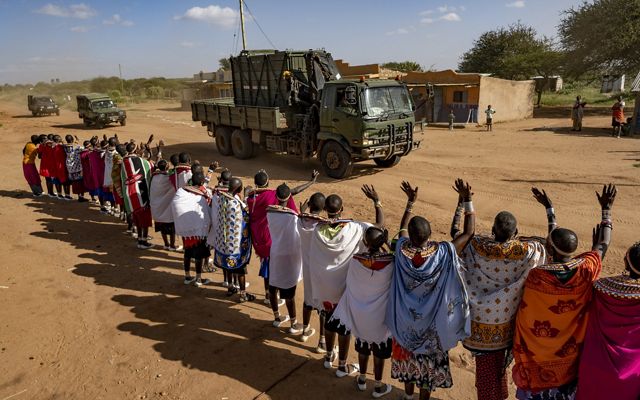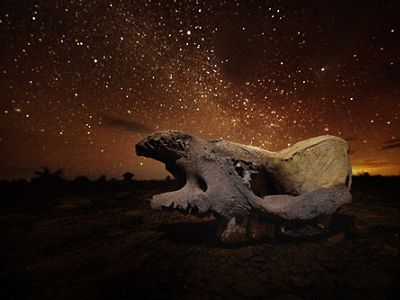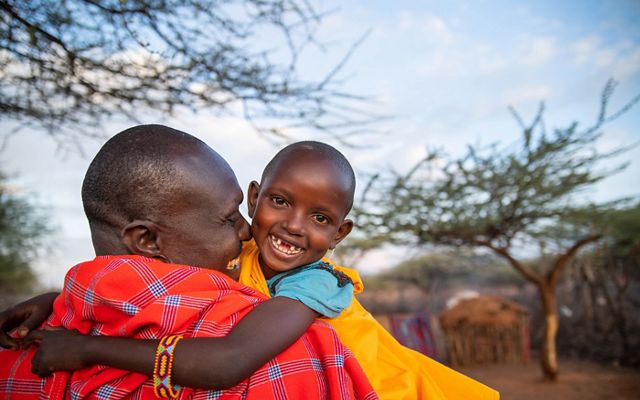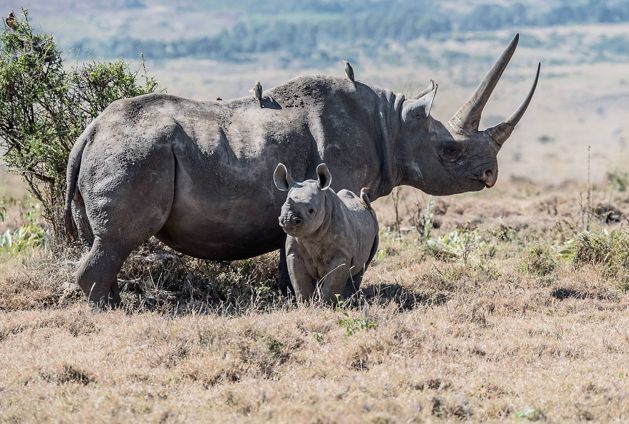
A New Home A black rhino stands in the grasses at Loisaba Conservancy for the first time in about 50 years. © Ami Vitale
On a Monday, it was Barry’s turn. He’d grown up on Lewa Conservancy, the 12th and final offspring of Solio, one of the first female black rhinos at Lewa. Over the course of his 12 years, Barry had seen dozens more rhinos born on Lewa and make it their home, too.
To the untrained eye, 93,000 acres looks like plenty of space for 260 rhinos to live. But for these solitary creatures, it can feel crowded quickly. And when any one rhino sanctuary reaches a certain number of animals—a number known as its carrying capacity—rhinos can stop breeding and begin fighting. This slows the black rhino’s climb from the brink of extinction.
So Barry was likely ready to be somewhere less crowded—a wide open space with lots of food, water, and room to roam. Luckily for Barry, he was headed to the brand-new rhino sanctuary at Loisaba Conservancy.

A Triumphant Return
Black rhinos were once abundant across Kenya, but rampant poaching in the 1970s and '80s nearly drove the species to extinction. By the mid-1980s, there were estimated to be fewer than 300 individuals left in the country. Government intervention stopped the decline, prompting a remarkable turnaround in their numbers. Today, Kenya is now about halfway to its goal of 2,000 individuals, the minimum number necessary to ensure the long-term survival of the species.
“I’m incredibly heartened that poaching, which wreaked havoc on our rhino populations, has dramatically decreased,” says Munira Bashir, director of The Nature Conservancy’s Kenya Program. “In fact, there have been close to zero poaching incidents for the last four years.”
The main limiting factor is now space. The opening of a 17th rhino sanctuary at Loisaba Conservancy will reduce the crowding at three existing sanctuaries—Lewa Conservancy, Ol Pejeta Conservancy, and Nairobi National Park—and contribute toward increasing the overall population. The 21 rhinos moved to Loisaba is only a starter breeding population; the conservancy can accommodate that number to grow to at least 50 in a safe environment. The 11 females and 10 males were carefully chosen by scientists to create the right mix of rhinos from different lineages for maximum breeding potential.

An Orchestrated Operations
Led by the Kenya Wildlife Service, this mammoth effort has required the close collaboration of a large team of partners over the last few years. TNC, San Diego Zoo Wildlife Alliance (SDZWA), and Space for Giants have played lead roles in funding the sanctuary and relocating the rhinos, and Elewana Collection has been a key partner and the conservancy's sole tourism provider.
Moving one 2,000-pound animal is no easy feat, and moving nearly two dozen of them takes incredible coordination, efficiency, and expertise. The 21 rhinos were moved over the course of about two weeks, three at a time. Kenya Wildlife Service veterinarians provided expertise with tranquilizing and handling rhinos, round-the-clock monitoring, and quick thinking in the face of unexpected challenges.
The translocation was implemented in adherence to the IUCN translocation guidelines and Immobilization and Translocation Protocol for Black Rhinoceros and White Rhinoceros in Kenya of 2019. On each capture day, three rhinos were carefully tranquilized, measured, tagged, and loaded into custom crates to keep them comfortable and safe on their journey. The three trucks then moved together in a slow caravan to Loisaba Conservancy.

Landing on Loisaba
A lot of effort went into ensuring Loisaba would be a suitable habitat for a new rhino population, and preparing for the rhinos' arrival took several years. Numerous assessments had to be conducted, including an ecological assessment, a disease risk assessment, a security assessment, an operations audit, and a fence survey with an accompanying environmental impact assessment.
Loisaba then had to construct specialized infrastructure, including a rhino-proof fence around about half of the conservancy. This low-profile fence with just a few wires can keep rhinos in while allowing most animals to go over, under, or through it. Fence gaps that consist of a sloping, loose rock wall will serve as corridors for elephants, giraffes, and other large mammals, but are insurmountable for rhinos due to their stubby legs.
In addition, Loisaba hired new rhino rangers and added new vehicles and state-of-the-art monitoring equipment. Funding raised by TNC, SDZWA, and Space for Giants will cover five years of operations costs, including ongoing veterinary care, habitat management, and community awareness.


Bringing Rhinos Home
Before the poaching crisis, rhinos were abundant on the land that is now Loisaba Conservancy. The last one seen on this landscape was in the mid-1970s. Bringing rhinos back to Loisaba is more than just an incredible conservation success story—it is the restoration of part of the local communities’ natural heritage.
Local community members will always have the opportunity to visit Loisaba to check out their new neighbors, and the conservancy regularly hosts school groups that go on game drives and learn about wildlife and environmental issues at their conservation center.
Quote: Lelaki Lekulal
The rhino is our heritage passed down from our fathers. We had lost them. They are good and we deserve to see them again.

The new additions could be beneficial in other ways as well. For example, having the Big Five at Loisaba will bring additional tourists, which means more jobs and more community development projects.
Nearly a decade ago, TNC and other partners brought funding to secure Loisaba Conservancy and transfer it to the holding of a Kenyan trust for long-term conservation. This move ensured it would remain a conserved wild landscape when other potential buyers may have developed the land unsustainably. Now Loisaba is able to play a critical role in achieving sustainability for these amazing animals.
“We at TNC are thrilled to contribute to this initiative, ensuring that Kenya's rhinos have the necessary room to roam,” Bashir said. “Our dedication remains unwavering in supporting the government and our partners in their endeavors to protect the long-term survival of these endangered species.”

Stay in the Loop
Sign up to Receive Updates about TNC's Conservation Work around the World


